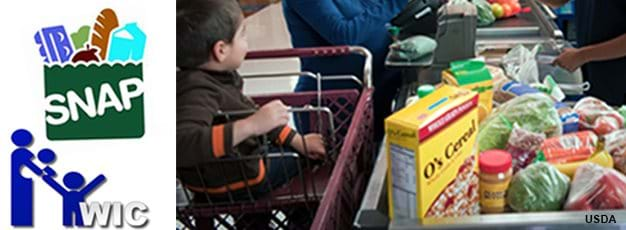Differences in Per-Person Food Costs for SNAP and WIC Have Widened Over Time

The Supplemental Nutrition Assistance Program (SNAP) is the largest of USDA’s food and nutrition assistance programs, providing benefits for participants to purchase food items at authorized food stores. SNAP is available to households with limited income and assets, subject to certain work and immigration status requirements. Benefit levels depend on household income and size, and SNAP benefits are reduced as a household’s income increases.
USDA’s third-largest assistance program—the Special Supplemental Nutrition Program for Women, Infants, and Children (WIC)—is more targeted than SNAP, providing eligible low-income pregnant, breastfeeding, and postpartum women as well as infants and children up to age 5 with specific types of supplemental foods, along with nutrition education and health care referrals. WIC food packages do not vary by household income.
SNAP is an entitlement program whereby everyone who meets the eligibility criteria and chooses to enroll receives benefits. WIC, on the other hand, is a discretionary program funded annually by congressional appropriations and can only serve as many participants as funding allows. In order to increase the number of people who can participate at a given appropriation level, WIC State agencies have instituted a variety of cost containment measures, the most significant of which has been the use of infant formula rebates. Starting in the late 1980s, WIC State agencies have obtained substantial discounts in the form of rebates from infant formula manufacturers for formula purchased through the program. In exchange for the rebates, a manufacturer is given the exclusive right to provide its product to WIC participants in that State. Rebates totaled $1.9 billion in fiscal 2013.
When WIC was initiated in 1974, the average monthly WIC food cost per person was similar to the average monthly SNAP benefit per person. However, food costs per person for SNAP and WIC have diverged significantly since then, with inflation-adjusted, or real, per-person SNAP benefits trending upward and real per-person WIC costs trending downward. Since the mid-1990s, real monthly food costs for WIC have remained relatively stable at about $43-$48 per person in fiscal 2013 dollars. However, real per-person food benefits for SNAP continue to fluctuate, due in large part to legislative changes that either increased or decreased benefit levels. For example, the American Recovery and Reinvestment Act of 2009 temporarily increased SNAP benefit levels beginning in April 2009, however over time, food price inflation eroded the increase. Average monthly real SNAP benefits fell from $145.34 per person in 2010 to $133.08 per person in 2013.
The Food Assistance Landscape: FY 2013 Annual Report, by Victor Oliveira, USDA, Economic Research Service, February 2014
Trends in Infant Formula Rebate Contracts: Implications for the WIC Program, by Victor Oliveira, Elizabeth Frazão, and David Smallwood, USDA, Economic Research Service, December 2013


